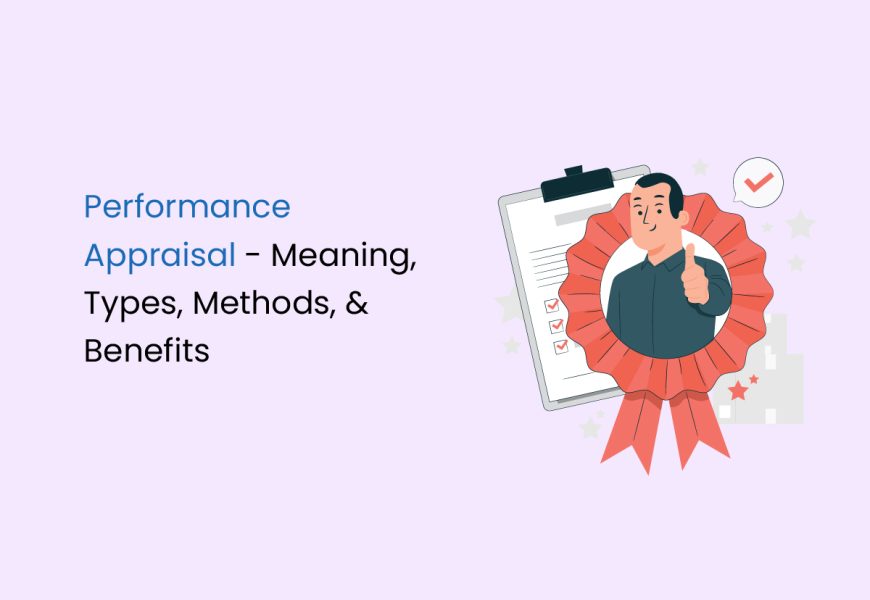Whether you’re a solo entrepreneur managing your own business or overseeing a team ranging from 1,000 employees to just one, assessing performance is crucial. While self-evaluation is straightforward for a one-person show, larger enterprises require a systematic approach to gauge employee effectiveness.
In this article, we will be discussing the significance of performance appraisals – a vital tool for objectively evaluating and enhancing employee performance. Read on to learn about the professional benefits and human-centric aspects of this essential business practice.
What is Performance Appraisal?
The term “performance appraisal” refers to the regular review of an employee’s job performance and overall contribution to a company. Also known as an annual review, employee appraisal, performance review or evaluation, a performance appraisal evaluates an employee’s skills, achievements, and growth, or lack thereof.
Companies use performance appraisals to give employees big-picture feedback on their work and to justify pay increases and bonuses, as well as termination decisions. They can be conducted at any given time but tend to be annual, semiannual, or quarterly.
Purpose of Performance Appraisals
The purpose of performance appraisals, typically crafted by human resources (HR) departments, is multifaceted. Primarily, they serve as a developmental tool for employees, offering constructive feedback on job performance. This ensures that individuals effectively manage and meet their set goals, with guidance provided on overcoming any shortcomings.
Performance appraisals are pivotal in allocating incentives such as raises and bonuses, especially when companies have a finite pool of funds. By evaluating employee contributions, companies can fairly reward top performers, contributing to overall growth.
Moreover, these appraisals facilitate the creation of a development plan for employees and their managers. This plan may involve additional training, increased responsibilities, and identifying areas for improvement, enabling employees to progress in their careers.
While performance appraisals are integral, fostering continuous communication between managers and employees throughout the year is essential. Regular conversations contribute to stronger relationships, alignment of goals, and a less stressful annual review process, ensuring ongoing collaboration and development.
What are Performance Appraisals For?
Performance appraisals have an important role in fostering mutual growth for both: organisations and employees.
- For organisations, these assessments serve as invaluable tools that offer insights into an employee’s contributions. This information empowers management to enhance working conditions, address behavioural concerns, acknowledge and leverage individual talents, and make informed decisions to drive strategic initiatives.
- For the employees, performance appraisals are not just a platform for recognition and appreciation but also an avenue for identifying opportunities for promotions or bonuses. They provide a pathway for obtaining relevant training or education to further career development and highlight areas for improvement. Engaging employees in conversations about long-term goals is a key aspect of these appraisals, fostering a sense of involvement and ownership in their career trajectory.
Furthermore, performance appraisals are pivotal in transferring, promotions, and termination decision-making processes.
- They supply essential data for identifying training and development needs, assisting in confirmation decisions post-probation, and determining salary adjustments or incentives.
- These appraisals facilitate effective communication between managers and their team members by clarifying expectations.
The overarching goal is to help employees reach their full potential performance level. Beyond immediate benefits, performance appraisals also serve as a means to collect pertinent employee data, maintaining comprehensive records for future organisational requirements. These evaluations contribute to a dynamic and mutually beneficial work environment where continuous improvement and development are at the forefront of organisational culture.
Types of Performance Appraisal
Performance appraisals come in various forms, each offering a unique perspective on evaluating employee performance. While the traditional top-down approach involves supervisors assessing their staff without the employee’s input, there are alternative methods:
- Self-assessment: Individuals evaluate their own job performance and behaviour, providing a self-reflection on their contributions and areas for improvement.
- Peer assessment: Colleagues within an individual’s workgroup or co-workers assess their performance, offering insights from those who closely collaborate with the subject.
- 360-degree feedback assessment: This comprehensive approach incorporates input from multiple sources, including the individual, supervisor, and peers. It provides a holistic view of performance from various perspectives.
- Negotiated appraisal: A more recent trend, this appraisal type involves a mediator to moderate the evaluation process. It aims to reduce the adversarial nature of performance evaluations by allowing the subject to be present first. Focusing on the positive aspects before criticism proves valuable in resolving conflicts between subordinates and supervisors.
These varied appraisal methods cater to different organisational needs, offering flexibility and a more comprehensive understanding of an individual’s performance.
How Do Performance Appraisals Work?
Performance appraisals operate as a strategic tool within organisations, primarily facilitated by Human Resources (HR) departments. Here’s how they typically work:
- Career Advancement and Feedback: HR departments design performance appraisals to aid employees in advancing their careers. These evaluations provide constructive feedback on job performance, ensuring individuals effectively manage and achieve their set goals. They serve as a mechanism to guide employees on how to reach their objectives if they fall short.
- Budget Allocation and Incentives: Performance evaluations are important in determining how a company allocates its limited budget for incentives, such as raises and bonuses. By assessing employee contributions, businesses can make informed decisions on fairly rewarding top performers, contributing to the overall growth of the organisation.
- Identifying Contributions and Rewards: Companies utilize performance reviews as a tool to identify employees who have made significant contributions to the company’s expansion. This identification allows organisations to reward their top-performing individuals, fostering motivation and loyalty appropriately.
- Areas for Improvement and Career Development: Performance appraisals serve as a constructive means for employees and their managers to identify areas for improvement. They help create employee development plans, including additional training and increased responsibilities. This strategic approach supports career advancement and overall professional growth.
Methods of Performance Appraisal
Performance appraisals have multiple forms. These are some of the few types that are recognised by managers and human resource staff:
- 720-Degree Feedback: Collects feedback not only from within the organisation but also from external stakeholders like customers, investors, and suppliers.
- Assessment Center Method: Conducts exercises at an assessment centre, evaluating employees through simulations, discussions, role-playing, and more.
- Behaviorally Anchored Rating Scale (BARS): Measures performance by comparing it with specific behaviour examples, each with a corresponding rating.
- Checklist Method: Utilises a simple checklist with yes/no answers for various traits.
- Critical Incidents Method: Considers specific critical behaviors, whether positive or negative, in evaluating employee performance.
- Customer/Client Reviews: Gathers feedback from clients and customers, especially regarding their perception of the employee and the business.
- Field Review Method: Involves an HR department or corporate representative conducting the employee’s performance evaluation.
- Forced Choice Method: Uses prepared True/False questions to assess employee performance.
- General Performance Appraisal: Involves continuous interaction between the manager and the employee, focusing on goal-setting and progress tracking.
- Human Resource Accounting Method: Examines the monetary value an employee brings to the company, considering both contributions and retention costs.
- Management By Objective (MBO): Collaborative goal-setting between the employee and manager, with regular discussions on progress and goal achievement.
- Performance Tests and Observations: Involves oral tests and challenges to measure employees’ skills and knowledge in their respective fields.
- Project Evaluation Review: Appraises team members at the end of each project, not just at the end of the business year.
- Rating Scales: Uses scales to rate attributes like dependability, initiative, and attitude, providing an overall performance assessment.
Criticisms for Performance Appraisal
While performance appraisals aim to motivate employees towards their goals, they face significant criticism:
Difficulty in Differentiating Individual and Organizational Performance
It’s often challenging to clearly separate individual performance from overall organisational performance. If the appraisal criteria don’t align with the organisation’s culture and objectives, it may result in a disconnect, causing dissatisfaction among employees.
Issues of Distrust and Tailored Input
Trust is vital in any performance appraisal process. When employees distrust the evaluation system, they may alter their feedback to please their superiors rather than provide genuine insights. This compromises the authenticity of the appraisal and hinders its effectiveness.
Unreasonable Goals and Ethical Concerns
In some cases, performance appraisals may lead to the setting of unrealistic goals. This can demoralise employees, pushing them towards unethical practices to meet unattainable targets. Critics argue that the emphasis on appraisals has diminished the use of fair merit- and performance-based compensation systems.
Likability Bias and Unfair Evaluations
The likability of an employee can sometimes outweigh their actual achievements in the evaluation process. Managers might be inclined to give positive reviews to maintain positive relationships, potentially leading to inflated evaluations that do not accurately reflect performance.
Unreliable Raters and Biases
The reliability of appraisals heavily depends on the accuracy and fairness of the raters. Biases introduced by raters can distort results, favouring certain characteristics or reflecting the personal preferences of the evaluator. This undermines the objectivity of the entire process.
Cultural and Contextual Variability
The effectiveness of performance appraisals is not universally applicable. What works well in one organisational culture or job function may not be suitable in another. Adapting the appraisal process to various contexts is essential to ensure its relevance and fairness.
Tips to Make Performance Appraisal Effective
Implementing these simple tips and techniques can help you enhance the effectiveness of your company’s performance appraisals.
Document Appraisal Sessions
- Take detailed notes during performance appraisal meetings and store them in a centralised database system.
- This documentation serves as a valuable resource for making informed decisions about employees and facilitates seamless follow-up discussions.
- Ensure easy access to these records, allowing for a comprehensive overview of an employee’s performance history.
Utilise Outlines for Consistency
- Develop a standardised outline template for conducting performance appraisals across the organisation.
- This structured approach fosters consistency in the review process, ensuring that all employees are evaluated against the same criteria.
- The use of outlines also helps employees prepare for their appraisal meetings, promoting transparency and fairness in the evaluation process.
Frequent Check-Ins for Timely Feedback
- Avoid the annual performance review surprise by conducting more frequent check-ins with employees.
- Regular feedback sessions provide employees with ongoing insights into their performance, helping them understand if they are on the right track.
- Timely communication allows for adjustments and improvements throughout the year, fostering a culture of continuous improvement.
Goal Alignment Discussion
- Use performance appraisals as a platform for discussing goal alignment between individual and organisational objectives.
- Encourage employees to share their career aspirations and discuss how their current role contributes to overall company goals.
- This approach ensures that performance discussions are linked to broader organisational strategies, enhancing employee engagement and motivation.
Development Plans and Training Opportunities
- Incorporate discussions about professional development and training needs during performance appraisals.
- Identify areas for skill enhancement and collaboratively create development plans to support employee growth.
- Offering training opportunities not only benefits individual employees but also contributes to the overall skill set and capabilities of the entire team.
Recognition and Positive Reinforcement
- Balance constructive feedback with positive reinforcement and recognition of achievements.
- Acknowledge and celebrate accomplishments to motivate employees and reinforce a culture of appreciation.
- Recognising and rewarding exemplary performance fosters a positive work environment and encourages employees to strive for excellence consistently.
FAQs about Performance Appraisal
What are the 3 types of performance appraisal?
Performance appraisals can be categorised into four significant types:
- 360-Degree Appraisal: Involves gathering feedback from supervisors, co-workers, group members, and self-assessment.
- Negotiated Appraisal: A process that incorporates a mediator, reducing the adversarial nature of evaluations.
- Peer Assessment: Colleagues within an individual's workgroup or co-workers assess their performance.
- Self-Assessment: Individuals evaluate their own job performance and behaviour.
What is the purpose of the performance appraisal?
Performance appraisal serves three basic functions: providing feedback on performance, serving as a basis for modifying behaviour, and offering data for managers to judge future job assignments.
What are the 5 key elements of performance appraisal?
The key elements include:
- Empowering Employees: Providing more power to the employee in the appraisal process.
- Correct Set of Parameters: Utilizing the right parameters for evaluation.
- 360-Degree Appraisal Method: Incorporating feedback from various sources.
- Motivation with Rewards and Recognitions: Using rewards and recognitions to boost motivation.
- Planning to Boost Performance: Developing strategies to enhance overall performance.
What are the 4 P's of performance appraisal?
The 4 Ps are People, Place, Product, and Processes. This approach helps teams break down key factors affecting employees, facilitating improvement in manageable and positive ways.
How often should performance appraisals be conducted?
The frequency of performance appraisals varies based on organisational practices, industry norms, and individual preferences. While many companies conduct annual appraisals, some opt for more frequent reviews, such as quarterly or semi-annually.
What are the challenges of performance appraisal?
Common challenges include subjectivity and bias, overemphasis on recent events, time constraints, negative perception, lack of specificity, goal setting and measurement issues, inadequate training for managers, focus on negatives only, link to compensation, and resistance to change.
How effective are appraisals?
The effectiveness of performance appraisals depends on their design, implementation, and utilisation within an organisation. When executed well, appraisals can be a valuable tool for performance management.
What are the 5 performance ratings?
While names may vary, a standard five-point scale includes:
- Outstanding/Exceeds Expectations
- Above Expectations/Exemplary/Very Good
- Meets Expectations/Proficient/Good
- Needs Improvement/Developing/Partially Meets Expectations
- Unsatisfactory/Does Not Meet Expectations
How do I write a good appraisal for myself?
Tips for writing a self-appraisal:
- Start early
- Review goals and objectives
- Be honest and objective
- Use data and metrics
- Focus on accomplishments
- Discuss challenges and solutions
- Use positive language
- Align with company values
- Include learning and development
- Seek feedback
- Be concise
- Review for clarity
- Avoid overconfidence
What not to say in a performance appraisal meeting?
During an appraisal meeting, avoid offensive remarks, excessive self-criticism, gossip, excuses, blaming others, and negative comparisons.
What if I am unhappy with my appraisal?
If unhappy, handle it professionally by reflecting, clarifying expectations, expressing concerns, asking for specific feedback, providing evidence, discussing development plans, and seeking opportunities for improvement.
How do I ask for a bigger hike in performance appraisal?
Prepare by listing accomplishments, researching industry benchmarks, and demonstrating positive impacts on the team or company. Communicate effectively, keeping in mind that not all salary requests may be granted.





















